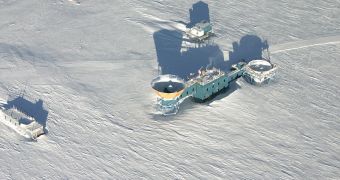The Polar Research Institute of China has completed the installation of the robotic observatory PLATeau only after two weeks from their arrival at the Dome Argus location on the Antarctic continent, the highest point of the Antarctic Plateau. PLATO has been built by the University of New South Wales, in Sydney, and is designed to work autonomously for most of the year.
Why the Antarctic continent? Antarctica is one of the best spots on the planet to make ground-based observations of the universe, due to the fact that it is one of the driest places on Earth, is thousands of kilometers away from any city lights, which can routinely prevent observations of the sky, and best of all, arctic nights last as much as six months. Because the plateau is situated deep inland, the observatory is also protected from eventual stormy conditions near the coast.
The facility will be powered during the summer with the help of an array of solar panels, while on winter time, highly efficient diesel engines will be used to generate the required amount of electric energy. According to the designers and builders of the PLATeau observatory, the fact that it does this entirely autonomous ultimately translates into a more environmentally friendly facility, by minimizing the amount of human intervention and support.
Dr. Lifan Wang, from Texas A&M University, argues that the telescope at Dome Argus will enable the possibility of making detailed observation of the universe at a much lower cost than that involved in sending a space telescope into Earth's orbit.
The instruments equipping the observatory will be provided by an international collaboration, consisting of more than 60 nations part of the International Polar Year, that have scheduled about 200 projects from physical, biological and social research topics. Such projects will involve experiments regarding the measurement of the darkness of the sky, atmospheric turbulences and observations in the very short microwave astronomy.
The Observatory consists of seven different telescopes, four provided by China, two from the Caltech Institute and one from the University of Arizona. The four telescopes built by China, each 14,5 centimeters in diameter, will make observations in different wavelengths, to view a large area of the sky over the South Pole, and will be able to create a continuous film that can last for as much as four months.
This way, astronomers can study the variability of the stars and may discover new exoplanets orbiting around extremely distant stars. During its journey, the PLATO covered more than 4,000 kilometers across the Australian continent, 18 days of travel by ocean, in order to reach the coast of the Antarctic continent. Once arrived in Antarctica, the PLATO observatory traveled another 18 days by sled along with 4,000 liters of jet fuel to ensure the required power in the coming winter. The PRIC team reached the Dome Argus on the 11th of January. Also, the Chinese team installed an automatic weather station, so that they would be able to monitor the conditions that would make suitable or not the installation of a permanent Arctic station in the Dome Argus area.
It is estimated that during winter time, temperatures can drop as low as -90 degrees Celsius, while the air pressure would be only half to the regular air pressure at sea level. The next mission to the PLATO observatory will be carried by a Chinese team somewhere in January 2009, until then however, it will be more than 600 kilometers away from the closest human being, and will have to be able to operate on its own until then.
China will allocate 25 million U.S. dollars to build a permanent Arctic station at Dome Argus, and has already developed plans for a large array complex of wide-field telescopes. The AST3 telescope, known as the Antarctic Schmidt Telescope, currently under construction, will be used to find Earth-like planets and to study supernovae explosions for cosmological studies.

 14 DAY TRIAL //
14 DAY TRIAL //